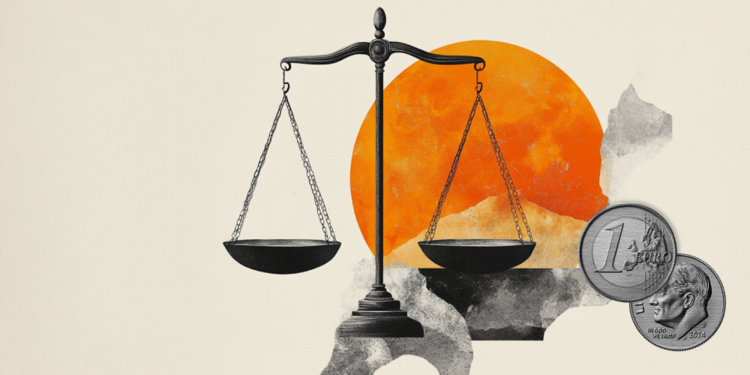Category: Forex News, News
Euro remains below key resistance area
EUR/USD holds its ground and trades in positive territory, slightly below 1.1750, in the European session on Friday. With the postponement of the release of the September employment data because of the US federal government shutdown, investors will scrutinize the Institute for Supply Management’s (ISM) Services Purchasing Managers’ Index (PMI) data for September.
Euro Price This week
The table below shows the percentage change of Euro (EUR) against listed major currencies this week. Euro was the strongest against the Canadian Dollar.
| USD | EUR | GBP | JPY | CAD | AUD | NZD | CHF | |
|---|---|---|---|---|---|---|---|---|
| USD | -0.26% | -0.39% | -1.37% | 0.23% | -0.79% | -0.66% | -0.09% | |
| EUR | 0.26% | -0.14% | -1.26% | 0.48% | -0.52% | -0.41% | 0.15% | |
| GBP | 0.39% | 0.14% | -1.05% | 0.62% | -0.45% | -0.27% | 0.29% | |
| JPY | 1.37% | 1.26% | 1.05% | 1.64% | 0.63% | 0.59% | 1.33% | |
| CAD | -0.23% | -0.48% | -0.62% | -1.64% | -0.97% | -0.89% | -0.33% | |
| AUD | 0.79% | 0.52% | 0.45% | -0.63% | 0.97% | 0.12% | 0.69% | |
| NZD | 0.66% | 0.41% | 0.27% | -0.59% | 0.89% | -0.12% | 0.71% | |
| CHF | 0.09% | -0.15% | -0.29% | -1.33% | 0.33% | -0.69% | -0.71% |
The heat map shows percentage changes of major currencies against each other. The base currency is picked from the left column, while the quote currency is picked from the top row. For example, if you pick the Euro from the left column and move along the horizontal line to the US Dollar, the percentage change displayed in the box will represent EUR (base)/USD (quote).
United States (US) President Donald Trump said on Wednesday that he will meet with Russ Vought, the head of the Office of Management and Budget, to see which federal programs could be cut. Additionally, the Trump administration announced that they froze $26 billion for Democratic-leaning states.
Markets could turn optimistic about the shutdown coming to an end soon, in case Democrats look to find a middle ground on the spending bill amid the threat of losing funds for their programs.
Nevertheless, the September employment report, which featured the Nonfarm Payrolls, Unemployment Rate and wage inflation figures, will not be released later in the day.
The ISM Services PMI is forecast to edge lower to 51.7 in September from 52 in August. In the absence of the NFP data, market participants could react to the Employment Index component of the survey, especially if the headline PMI arrives near the market expectation. If the Employment Index recovers above 50 and shows an increase in the service sector payrolls, the USD could gather strength heading into the weekend and cause EUR/USD to turn south. On the flip side, EUR/USD could gather bullish momentum in the American session if this data comes in below the August print of 46.5.
EUR/USD Technical Analysis
The Relative Strength Index (RSI) indicator on the 4-hour chart moves sideways near 50 and EUR/USD fluctuates between the 20-day and the 50-day Simple Moving Average (SMA), reflecting a neutral stance in the near term.
On the upside, 1.1750-1.1770 aligns as a strong resistance area, where the Fibonacci 23.6% retracement of the latest uptrend meets the 100-period SMA and the 20-day SMA. If EUR/USD manages to clear that hurdle, 1.1820 (static level) could be seen as the next resistance level before 1.1900 (static level, round level).
On the downside, the first support area is located 1.1710-1.1690 (200-period SMA, Fibonacci 38.2% retracement, 50-day SMA) ahead of 1.1640 (Fibonacci 50% retracement).
Euro FAQs
The Euro is the currency for the 19 European Union countries that belong to the Eurozone. It is the second most heavily traded currency in the world behind the US Dollar. In 2022, it accounted for 31% of all foreign exchange transactions, with an average daily turnover of over $2.2 trillion a day.
EUR/USD is the most heavily traded currency pair in the world, accounting for an estimated 30% off all transactions, followed by EUR/JPY (4%), EUR/GBP (3%) and EUR/AUD (2%).
The European Central Bank (ECB) in Frankfurt, Germany, is the reserve bank for the Eurozone. The ECB sets interest rates and manages monetary policy.
The ECB’s primary mandate is to maintain price stability, which means either controlling inflation or stimulating growth. Its primary tool is the raising or lowering of interest rates. Relatively high interest rates – or the expectation of higher rates – will usually benefit the Euro and vice versa.
The ECB Governing Council makes monetary policy decisions at meetings held eight times a year. Decisions are made by heads of the Eurozone national banks and six permanent members, including the President of the ECB, Christine Lagarde.
Eurozone inflation data, measured by the Harmonized Index of Consumer Prices (HICP), is an important econometric for the Euro. If inflation rises more than expected, especially if above the ECB’s 2% target, it obliges the ECB to raise interest rates to bring it back under control.
Relatively high interest rates compared to its counterparts will usually benefit the Euro, as it makes the region more attractive as a place for global investors to park their money.
Data releases gauge the health of the economy and can impact on the Euro. Indicators such as GDP, Manufacturing and Services PMIs, employment, and consumer sentiment surveys can all influence the direction of the single currency.
A strong economy is good for the Euro. Not only does it attract more foreign investment but it may encourage the ECB to put up interest rates, which will directly strengthen the Euro. Otherwise, if economic data is weak, the Euro is likely to fall.
Economic data for the four largest economies in the euro area (Germany, France, Italy and Spain) are especially significant, as they account for 75% of the Eurozone’s economy.
Another significant data release for the Euro is the Trade Balance. This indicator measures the difference between what a country earns from its exports and what it spends on imports over a given period.
If a country produces highly sought after exports then its currency will gain in value purely from the extra demand created from foreign buyers seeking to purchase these goods. Therefore, a positive net Trade Balance strengthens a currency and vice versa for a negative balance.
Written by : Editorial team of BIPNs
Main team of content of bipns.com. Any type of content should be approved by us.
Share this article:










